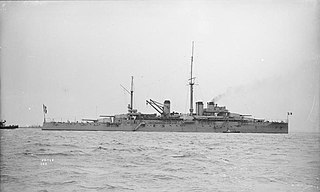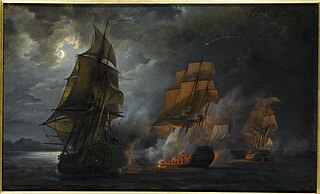
Jean Bart was a French naval commander and privateer.

Jean Bart was a French fast battleship, the second and final member of the Richelieu class. Built as a response to the Italian Littorio class, the Richelieus were based on their immediate predecessors of the Dunkerque class with the same unconventional arrangement that grouped their main battery forward in two quadruple gun turrets. They were scaled up to accommodate a much more powerful main battery of eight 380 mm (15 in) guns, with increased armor to protect them from guns of the same caliber. Jean Bart was laid down in 1936 and was launched in 1940, following the outbreak of World War II in Europe. The ship was not complete by the time Germany won the Battle of France, and Jean Bart was rushed to Casablanca to escape advancing German troops. She had only one of her main turrets installed, along with a handful of anti-aircraft guns.

The Battle of Dogger Bank is the name of a battle which took place on 17 June 1696 as part of the War of the Grand Alliance. It was a victory for a French force of seven ships over a Dutch force of five ships and the convoy it was escorting.

The Battle of Texel was a sea battle fought during the Nine Years' War on 29 June 1694, when a force of 8 French ships, under Jean Bart, recaptured a French convoy, which had earlier that month been taken by the Dutch, and captured 3 ships of the 8-ship escorting force under Hidde de Vries. De Vries was captured by the French, but shortly after died of wounds.

Valmy, named after the Battle of Valmy, was the largest three-decker of the French Navy, and the largest tall ship ever built in France.

France was the last of four Courbet-class battleships, the first dreadnoughts built for the French Navy. The ship was completed just before the start of World War I in August 1914. Even though France was not officially completed, she ferried the President of France to Russia during the July Crisis for consultations. She spent the war providing cover for the Otranto Barrage that blockaded the Austro-Hungarian Navy in the Adriatic Sea and sometimes served as a flagship. After the war France and her sister ship Jean Bart participated in the occupation of Constantinople and were then sent to the Black Sea in 1919 to support Allied troops in the Southern Russia Intervention. The war-weary crews of both ships briefly mutinied, but it was easily put down and she returned to France mid-year. Striking an uncharted rock off the French coast in 1922, she foundered four hours later.

The Courbet-class battleships were the first dreadnoughts built for the French Navy. These were completed prior to WWI. The class comprised four ships: Courbet, France, Jean Bart, and Paris. All four ships were deployed to the Mediterranean Sea for the entirety of World War I, spending most of their time escorting French troop convoys from North Africa and covering the Otranto Barrage. An Anglo-French fleet led by Courbet succeeded in sinking the Austro-Hungarian protected cruiser Zenta in the Battle of Antivari. Jean Bart was torpedoed in the bow by U-12 on 21 December 1914, but she was able to steam to Malta for repairs.

The Richelieu class were fast battleships built for the French Navy between the 1930s and 1950s. Initially two ships were ordered in 1935 in response to Italian orders for the Littorio-class battleships the previous year. The Richelieus were based on the preceding Dunkerque class, but scaled up to accommodate more powerful 380 mm (15 in) guns and armor to protect them from guns of the same caliber. To keep the ships within the displacement limits imposed by the Washington Naval Treaty, they featured the same concentrated arrangement as the Dunkerques for the main battery: two quadruple gun turrets placed forward. They also incorporated new, more compact boilers that allowed for a shorter hull for the desired top speed. After Germany ordered two Bismarck-class battleships, France responded with another pair of Richelieus, to be built to modified designs. The first, Clemenceau, would have received modified secondary and anti-aircraft batteries, while Gascogne would have had had her superfiring main battery turret shifted aft, along with other changes. Clemenceau was never completed, and Gascogne was never laid down.

Courbet was the lead ship of her class of four dreadnought battleships, the first ones built for the French Navy. She was completed shortly before the start of World War I in August 1914. She spent the war in the Mediterranean, where she helped to sink an Austro-Hungarian cruiser, covered the Otranto Barrage that blockaded the Austro-Hungarian Navy in the Adriatic Sea, and often served as a flagship. Although upgraded several times before World War II, she was not considered to be a first-line battleship by the 1930s and spent much of that decade as a gunnery training ship.
Jean Bart may refer to one of the following ships of the French Navy or privateers named in honour of Jean Bart, a French naval commander and privateer.

Jean Bart was a protected cruiser of the Jean Bart class built for the French Navy in the late 1880s and early 1890s. The lead ship the class of two ships, Jean Bart and her sister ship were ordered during the tenure of Admiral Théophile Aube as Minister of Marine according to the theories of the Jeune École doctrine. The ships were intended as long-range commerce raiders, and they were armed with a main battery of four 164 mm (6.5 in) guns, were protected by an armor deck that was 50 to 100 mm thick, and were capable of steaming at a top speed of 19.5 knots.

Jean Bart was the second of four Courbet-class battleships, the first dreadnoughts built for the French Navy. She was completed before World War I as part of the 1910 naval building programme. She spent the war in the Mediterranean and helped to sink the Austro-Hungarian protected cruiser Zenta on 16 August 1914. She was torpedoed by an Austro-Hungarian submarine in December and steamed to Malta for repairs that required three and a half months. She spent the rest of the war providing cover for the Otranto Barrage that blockaded the Austro-Hungarian Navy in the Adriatic Sea and sometimes served as a flagship.

The Austerlitz was a late 100-gun Hercule-class ship of the line of the French Navy.

Jean Bart was a Téméraire class 74-gun ship of the line of the French Navy.

The Donawerth was a 90-gun Suffren class ship of the line of the French Navy.

HMS Arab was the French 20-gun corvette Jean Bart, launched in 1793. The British captured her in 1795 and the Royal Navy took her into service. She was wrecked in 1796.

HMS Jupiter was a 50-gun Portland-class fourth-rate ship of the Royal Navy. She served during the American War of Independence, the French Revolutionary Wars, and the Napoleonic Wars in a career that spanned thirty years. She was also one of the fastest ships in the Royal Navy as shown by her attempt to capture the cutter Eclipse under Nathaniel Fanning.

The Duguesclin was a 90-gun Ship of the line of the French Navy. She was the second ship in French service named in honour of Bertrand du Guesclin.

The Jean Bart class comprised two protected cruisers of the French Navy built in the late 1880s and early 1890s; the two ships were Jean Bart and Isly. They were ordered as part of a fleet program that accorded with the theories of the Jeune École, which proposed a fleet based on cruisers and torpedo boats to defend France. The Jean Bart-class cruisers were intended to serve a long-range commerce raiders to attack enemy merchant shipping. The ships were armed with a main battery of four 164 mm (6.5 in) guns supported by six 138 mm (5.4 in) guns and they had a top speed of 19 to 19.5 knots.

Jean Bart was a French privateer launched in Marseille in 1807, and commissioned as a privateer by the Daumas brothers. She was the first privateer captained by Jean-Joseph Roux.
















